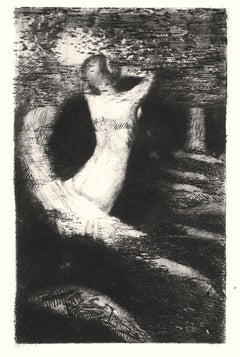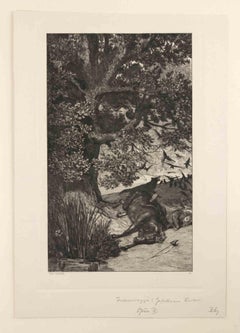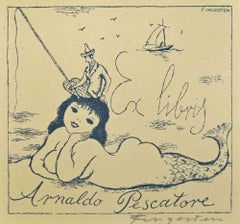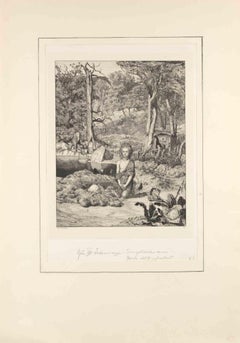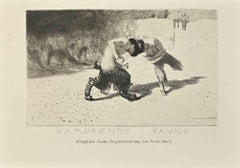Symbolist Prints and Multiples
to
174
452
49
93
7
3
Overall Width
to
Overall Height
to
21,271
18,648
10,632
6,303
5,048
2,714
1,554
1,398
1,327
883
848
438
346
202
96
40
38
37
34
2
83
498
24
17
94
100
89
8
9
21
14
7
4
433
161
8
385
241
183
113
109
83
73
37
32
31
29
27
25
19
19
15
13
12
12
11
212
156
98
87
62
30
359
352
138
Style: Symbolist
Passage d'une Ame - Etching by O. Redon - 1891
By Odilon Redon
Located in Roma, IT
Passage of a Spirit is an original etching, realized by Odilon Redon in 1891, frontispiece for “La Passante”, edition of 420 copies, titled: " Passage d’une âme ".
Image dimensio...
Category
1890s Symbolist Prints and Multiples
Materials
Etching
$1,227 Sale Price
20% Off
Fallen Rider - Etching by Max Klinger - 1881
By Max Klinger
Located in Roma, IT
Fallen Rider is a modern artwork realized by Max Klinger in 1881.
The artwork belongs to a series of prints called Intermezzi realized by Max Klinger, published by Nurnberg: Stroef...
Category
1880s Symbolist Prints and Multiples
Materials
Etching
Ex Libris - Arnaldo Pescatore - Woodcut by Michel Fingesten - 1930s
Located in Roma, IT
Ex Libris Arnaldo Pescatore- is a woodcut print created by Michel Fingesten.
Hand Signed on the lower right margin.
Good conditions.
Michel Fingesten (1884 - 1943) was a Czech...
Category
1930s Symbolist Prints and Multiples
Materials
Woodcut
Simplicius at the Hermit's Grave - Etching by Max Klinger - 1881
By Max Klinger
Located in Roma, IT
Simplicius at the Hermit's Grave- Simplicius am Grabe des Einsiedlers (plate VIII) belongs to a series of prints called Intermezzi realized by Max Klinger, published by Nurnberg: Str...
Category
1880s Symbolist Prints and Multiples
Materials
Etching
Opus IV Unter den Soldaten Rad - Etching by Max Klinger - 1881
By Max Klinger
Located in Roma, IT
Opus IV Unter den Soldaten Rad belongs to a series of prints called Intermezzi realized by Max Klinger, published by Nurnberg: Stroefer, 1881.
Etching on paper.
Signed in the plate...
Category
1880s Symbolist Prints and Multiples
Materials
Etching
Kampfende Faune - Etching by Franz von Stuck - Early 20th Century
Located in Roma, IT
Kampfende Faune is an artwork realized by Franz von Stuck in the early 20th Century.
Etching.
Category
Early 20th Century Symbolist Prints and Multiples
Materials
Etching
Love, Death and the Beyond - Etching by Max Klinger - 1881
By Max Klinger
Located in Roma, IT
Love, Death and the Beyond is a original modern artwork realized by Max Klinger in 1881.
The artwork belongs to a series of prints called Intermezzi realized by Max Klinger, publish...
Category
1880s Symbolist Prints and Multiples
Materials
Etching
Love, Death and the Beyond - Etching by Max Klinger - 1881
By Max Klinger
Located in Roma, IT
Running Death from Intermezzi belongs to a series of prints called Intermezzi realized by Max Klinger, published by Nurnberg: Stroefer, 1881.
Etching on paper.
Signed and dated on ...
Category
1880s Symbolist Prints and Multiples
Materials
Etching
Lockung - Vintage Héliogravure by Franz von Bayros - Early 20th Century
Located in Roma, IT
"Lockung" is an original Black and white héliogravure on cream-colored cardboard realized by Choisy Le Conin, pseudonym of Franz Von Bayros (Agram, 1866 – Vienna, 1924).
From Mappe, ...
Category
Early 20th Century Symbolist Prints and Multiples
Materials
Engraving
Suzanne Benton, Child of Fortune, 2017, Monoprint
Located in Darien, CT
“I still look at and learn from the art of the past, and enjoy making interpretations of works which I admire.” Henry Moore
Infanta, Floating Balance, Point in Time, and Visionary are monoprints with Chine collé from Suzanne Benton's Paintings in Proust series. This grouping also includes the dry-point etching with Chine collé. Infanta (edition of 10). The monoprints (unique prints) employ the collage technique, chine collé (glued paper). Collé papers are pre-inked and hand-painted. Dimensional printing plates emboss texture onto the prints. The plates are inked individually for each solo print. The images and collé papers are then laid onto the plate and adhere to the printmaking paper as the plate and paper run through the etching press.
Other monoprint series have been devoted to Indian and Turkish miniature painting...
Category
2010s Symbolist Prints and Multiples
Materials
Monoprint
Venus in Muschelwagen - Etching by E. Einschlag after M. Klinger - 1907
By Max Klinger
Located in Roma, IT
Venus in Muschelwagen is a superb black and white etching on paper, realized in 1907 by the German artist Eduard Einschlag (Leipzig 1879 -1945), after Max Klinger (Leipzig 1857 - Gro...
Category
Early 1900s Symbolist Prints and Multiples
Materials
Etching
$2,891 Sale Price
30% Off
Kämpfende Kentauren - Etching by Max Klinger - 1881
By Max Klinger
Located in Roma, IT
Kämpfende Kentauren (Fighting Centaurs), is an etching and aquatint realized by Max Klinger in 1881. Plate V from “Intermezzi” Opus IV, 2nd state on 2, first edition.
Here the art...
Category
1880s Symbolist Prints and Multiples
Materials
Etching
Moonlit Night from Intermezzi - Etching by Max Klinger - 1881
By Max Klinger
Located in Roma, IT
Moonlit Night from Intermezzi belongs to a series of prints called Intermezzi realized by Max Klinger, published by Nurnberg: Stroefer, 1881.
Etching on paper.
Signed in the plate
...
Category
1880s Symbolist Prints and Multiples
Materials
Etching
He wrote in the Tables the wordes of the covenant, even the Ten Commandments
By Marc Chagall
Located in OPOLE, PL
This work will be exhibited at Art on Paper NYC, September 4–7, 2025.
–
Marc Chagall (1887-1985) - He wrote in the Tables the wordes of the covenant, even the Ten Commandments
Li...
Category
1960s Symbolist Prints and Multiples
Materials
Lithograph
$1,793 Sale Price
20% Off
Untitled - Etching by Otto Hans Beier - Early 20th Century
Located in Roma, IT
Etching on vélin paper, realized by Beier in the early 20th Century.
Signed on the plate at the top right, countersigned in pencil at the bottom right.
Good condition.
Category
1920s Symbolist Prints and Multiples
Materials
Etching
Andra Samelson, Jalü #8, archival pigment print on canvas, Ed. 1/5, Rainbows
Located in Darien, CT
Rainbow Light can manifest anywhere and anytime, representing ominscience and it can dissolve instantly, representing impermanence. It is without shadow and represents awareness with...
Category
2010s Symbolist Prints and Multiples
Materials
Archival Pigment
Ex Libris - Etching by Michel Fingesten - 1930s
Located in Roma, IT
"Ex Libris" is an Etching, Ex Libris, on ivory-colorated paper by Michel Fingesten .
In excellent conditions: As good as new.
Hand-signed in pencil, on the lower right.
Container...
Category
1930s Symbolist Prints and Multiples
Materials
Etching
Suzanne Benton, Male Grace, 2017, Monoprint
Located in Darien, CT
“I still look at and learn from the art of the past, and enjoy making interpretations of works which I admire.” Henry Moore
Infanta, Floating Balance, Point in Time, and Visionary are monoprints with Chine collé from Suzanne Benton's Paintings in Proust series. This grouping also includes the dry-point etching with Chine collé. Infanta (edition of 10). The monoprints (unique prints) employ the collage technique, chine collé (glued paper). Collé papers are pre-inked and hand-painted. Dimensional printing plates emboss texture onto the prints. The plates are inked individually for each solo print. The images and collé papers are then laid onto the plate and adhere to the printmaking paper as the plate and paper run through the etching press.
Other monoprint series have been devoted to Indian and Turkish miniature painting...
Category
2010s Symbolist Prints and Multiples
Materials
Monoprint
Suzanne Benton, Maiden and the Night, 2017, Monoprint
Located in Darien, CT
“I still look at and learn from the art of the past, and enjoy making interpretations of works which I admire.” Henry Moore
Infanta, Floating Balance, Point in Time, and Visionary are monoprints with Chine collé from Suzanne Benton's Paintings in Proust series. This grouping also includes the dry-point etching with Chine collé. Infanta (edition of 10). The monoprints (unique prints) employ the collage technique, chine collé (glued paper). Collé papers are pre-inked and hand-painted. Dimensional printing plates emboss texture onto the prints. The plates are inked individually for each solo print. The images and collé papers are then laid onto the plate and adhere to the printmaking paper as the plate and paper run through the etching press.
Other monoprint series have been devoted to Indian and Turkish miniature painting...
Category
2010s Symbolist Prints and Multiples
Materials
Monoprint
Abel Pann Israeli Bezalel School Lithograph Judaica Biblical Print Jewish Art
By Abel Pann
Located in Surfside, FL
Abel Pann (1883–1963) was a European Jewish painter who settled in the Talpiot neighborhood of Jerusalem in the early twentieth century and taught at the Bezalel Academy of Art under...
Category
Mid-20th Century Symbolist Prints and Multiples
Materials
Lithograph
The European Macabre Dance N.4 - Lithograph by A. Martini - 1915
Located in Roma, IT
The European Macabre Dance N.4 is a hand-colored lithograph, from the Series "La Danza Macabra Europea" illustrated by Alberto Martini (Oderzo, 1876 – Milan, 1954) in 1915.
Signed ...
Category
1910s Symbolist Prints and Multiples
Materials
Lithograph
Romance - Etching by André Suares - 1926
Located in Roma, IT
Romance is from Illustrations for Cressidra, a print on paper realized by André Suares in 1926.
Etching and drypoint
Edition of 200 print
Good conditions.
Category
1920s Symbolist Prints and Multiples
Materials
Etching, Drypoint
Le Fleur Du Marécage - after Odilon Redon - 1923
By Odilon Redon
Located in Roma, IT
Le Fleur Du Marécage is a phototype reproduction realized after Odilon Redon.
They belong to the suite "Odilon Redon Peintre, Dessinateur et Graveur", published by Henri Felury in ...
Category
1920s Symbolist Prints and Multiples
Materials
Photogravure
Pauls Duškins(1928-1996) Rasputin, paper/etching, 14/15, 63x49 cm, 1975
Located in Riga, LV
Pauls Duškins(1928-1996)
Rasputin, paper/etching, 14/15, 63x49 cm, 1975
Category
1970s Symbolist Prints and Multiples
Materials
Paper, Etching
Simplicius at the Hermit's Grave - Etching by Max Klinger - 1881
By Max Klinger
Located in Roma, IT
Simplicius at the Hermit's Grave- Simplicius am Grabe des Einsiedlers (plate VIII) belongs to a series of prints called Intermezzi realized by Max Klinger, published by Nurnberg: Str...
Category
1880s Symbolist Prints and Multiples
Materials
Etching
La Chimère aux Yeux Verts - Lithograph by O. Redon - 1888
By Odilon Redon
Located in Roma, IT
Chimera with Green Eyes is an original lithograph on Chine collé, realized by Odilon Redon in 1888, plate 7 from “Les tentations de St.Antoine” (1ère série), unique state, first e...
Category
1880s Symbolist Prints and Multiples
Materials
Etching
$3,209 Sale Price
20% Off
Immagine Feroce by Enzo Cucchi, portfolio of mythological ocean scene drawings
By Enzo Cucchi
Located in New York, NY
Whimsical, mysterious seascapes, animals, and mythological figures weave throughout this expressive set of black and white Enzo Cucchi lithographs. The complete set of five lithograp...
Category
1980s Symbolist Prints and Multiples
Materials
Lithograph
Lovers II, original serigraph Lovers.
Located in La Canada Flintridge, CA
This original serigraph by Huibert Sabelis, titled Lovers, features two modern figures, abstractly portrayed in Sabelis's distinctive style. The composition harmonizes warm tones of ...
Category
1980s Symbolist Prints and Multiples
Materials
Color
Die Versuchung des Heiligen Antonius - Original Lithograph by A. Kubin - 1922
By Alfred Kubin
Located in Roma, IT
Die Versuchung des Heiligen Antonius is an original lithograph on simili japanese paper, realized by Alfred Kubin in 1922, Hand-signed, edition of 100 copies.
Ref.: Arnason & Wheel...
Category
1920s Symbolist Prints and Multiples
Materials
Lithograph
Psyche in Tartarus - Etching by Max Klinger - 1909
By Max Klinger
Located in Roma, IT
Etching and aquatint realized in 1909.
Belongs to the series "Amor und Psyche. Opus V".
Very good condition.
Category
Early 1900s Symbolist Prints and Multiples
Materials
Etching
Meeresidylle - Etching after Arnold Böcklin - Early 20th Century
Located in Roma, IT
Etching after Bocklin, realized in the early 20th Century.
Titled in the plate in bottom center.
Published by Druck & Verlag.
Very good condition.
Category
Early 20th Century Symbolist Prints and Multiples
Materials
Etching
Josephslegende II. Richard Strauss Oper - Etching by Alois Kolb - 1922
Located in Roma, IT
Etching realized in 1922 to illustrate Richard Strauss' work.
Hand signed in pencil ower right.
A tear in the right margin and a corner crease in the upper right, otherwise overall...
Category
1920s Symbolist Prints and Multiples
Materials
Etching
Renaissance - Etching by J. von Diveki - 1920
Located in Roma, IT
Etching realized by Josef von Diveky in 1920.
Image dimension 19x13 cm.
Edition of 78/100.
Signed and dated in pencil lower right, titled in pencil lower left. Numbered in pencil ...
Category
1920s Symbolist Prints and Multiples
Materials
Etching
Die Zisterne - Vintage Héliogravure by Franz von Bayros - 1921 ca.
Located in Roma, IT
Die Zisterne is a black and white héliogravure on cream-colored cardboard realized by Choisy Le Conin, pseudonym of Franz Von Bayros (Agram, 1866 – Vienna, 1924).
From Mappe, a port...
Category
1920s Symbolist Prints and Multiples
Materials
Engraving
Abel Pann Israeli Bezalel School Lithograph Judaica Biblical Print Jewish Art
By Abel Pann
Located in Surfside, FL
Abel Pann (1883–1963) was a European Jewish painter who settled in the Talpiot neighborhood of Jerusalem in the early twentieth century and taught at the Bezalel Academy of Art under...
Category
Mid-20th Century Symbolist Prints and Multiples
Materials
Lithograph
Landslide from Intermezzi - Etching by Max Klinger - 1881
By Max Klinger
Located in Roma, IT
Landslide from Intermezzi belongs to a series of prints called Intermezzi realized by Max Klinger, published by Nurnberg: Stroefer, 1881.
Etching on paper.
Signed on the plate
Goo...
Category
1880s Symbolist Prints and Multiples
Materials
Etching
$826 Sale Price
30% Off
Erfüllung - Vintage Héliogravure by Franz von Bayros - 1921 ca.
Located in Roma, IT
Erfüllung is a black and white héliogravure on cream-colored cardboard realized by Choisy Le Conin, pseudonym of Franz Von Bayros (Agram, 1866 – Vienna, 1924).
From Mappe, a portfol...
Category
1920s Symbolist Prints and Multiples
Materials
Engraving
Opus IV, Simplicius in der Waldeinode - Etching by Max Klinger - 1881
By Max Klinger
Located in Roma, IT
Opus IV, Simplicius in der Waldeinode (Simplicius in the Wilderness) belongs to a series of prints called Intermezzi realized by Max Klinger, published by Nurnberg: Stroefer, 1881.
...
Category
1880s Symbolist Prints and Multiples
Materials
Etching
Jonah II
By Marc Chagall
Located in OPOLE, PL
Marc Chagall (1887-1985) - Jonah II
Lithograph from 1972.
This impression is notated as “Epreuve d’exposition H.C”. apart from the edition of 50 on Japon paper.
Unsigned and unnum...
Category
1970s Symbolist Prints and Multiples
Materials
Lithograph
$4,625 Sale Price
20% Off
Abel Pann Israeli Bezalel School Lithograph Judaica Biblical Print Jewish Art
By Abel Pann
Located in Surfside, FL
Abel Pann (1883–1963) was a European Jewish painter who settled in the Talpiot neighborhood of Jerusalem in the early twentieth century and taught at the Bezalel Academy of Art under...
Category
Mid-20th Century Symbolist Prints and Multiples
Materials
Lithograph
Illustration from the Series "Les Fleurs du Mal" after Odilon Redon - 1923
By Odilon Redon
Located in Roma, IT
Illustration from the series "Les Fleurs du Mal" is an etching print realized after Odilon Redon and published by Henri Felury in 1923.
Monogrammed on the plate.
Good conditions.
...
Category
1920s Symbolist Prints and Multiples
Materials
Lithograph
Ex Libris - Giorgio Balbi - Etching by Alberto Martini - Mid-20th Century
Located in Roma, IT
Ex Libris - Giorgio Balbi - Piu Forte della Morte è Amore is an Artwork realized by Alberto Martini in Mid 20th Century.
Category
Mid-20th Century Symbolist Prints and Multiples
Materials
Etching
Zao Wou-ki - Sans titre
By Marc Chagall
Located in OPOLE, PL
Zao Wou-Ki (1921-2013) - Sans titre
Lithograph from 1967.
Edition 420/700.
Dimensions of work: 31 x 23 cm
Publisher: Galerie de France, Paris.
Printed by: E. and J. Dejobert, Pa...
Category
1960s Symbolist Prints and Multiples
Materials
Lithograph
$1,793 Sale Price
20% Off
Ex Libris - Juan Sastre - Woodcut - Mid 20th Century
Located in Roma, IT
Ex Libris - Juan Sastre is a Modern Artwork realized in Mid 20th Century
B/W woodcut on paper.
The work is glued on cardboard.
Total dimensions: 21x 15 cm.
Excellent conditi...
Category
Mid-20th Century Symbolist Prints and Multiples
Materials
Woodcut
$127 Sale Price
40% Off
Illustration from the series "Les Fleurs du mal" - Etching After O. Redon
By Odilon Redon
Located in Roma, IT
Monogram of the artist on plate. Edition of 150 copies. One of the 50 H.C.copies in Roman Numerals. This print is one of the illustrations realized by Odilon Redon for an important e...
Category
1920s Symbolist Prints and Multiples
Materials
Etching
Kindness - Etching by Félicien Rops - 1880s
Located in Roma, IT
Original Title: "Complaisance". Hand signed with red pencil. Artist's Proof. Reference: E.N.372
Rare and in very good condition.
Category
1880s Symbolist Prints and Multiples
Materials
Etching
Knight and Lady - Original Woodcut Print - Early 20th Century
Located in Roma, IT
Cavalier and Lady is an original woodcut print on paper, realized by unknown Artist of the early 20th Century.
Hand-signed on lower right, illegible.
Included a Passepartout: 25 x...
Category
Early 20th Century Symbolist Prints and Multiples
Materials
Woodcut
Andra Samelson, Jalü #6 archival pigment print on canvas, Ed. 1/5, Rainbows
Located in Darien, CT
Rainbow Light can manifest anywhere and anytime, representing ominscience and it can dissolve instantly, representing impermanence. It is without shadow and represents awareness with...
Category
2010s Symbolist Prints and Multiples
Materials
Archival Pigment
Suzanne Benton, Renaissance Maiden, 2017, Monoprint
Located in Darien, CT
“I still look at and learn from the art of the past, and enjoy making interpretations of works which I admire.” Henry Moore
Infanta, Floating Balance, Point in Time, and Visionary are monoprints with Chine collé from Suzanne Benton's Paintings in Proust series. This grouping also includes the dry-point etching with Chine collé. Infanta (edition of 10). The monoprints (unique prints) employ the collage technique, chine collé (glued paper). Collé papers are pre-inked and hand-painted. Dimensional printing plates emboss texture onto the prints. The plates are inked individually for each solo print. The images and collé papers are then laid onto the plate and adhere to the printmaking paper as the plate and paper run through the etching press.
Other monoprint series have been devoted to Indian and Turkish miniature painting...
Category
2010s Symbolist Prints and Multiples
Materials
Monoprint
Abel Pann Israeli Bezalel School Lithograph Judaica Biblical Print Jewish Art
By Abel Pann
Located in Surfside, FL
Abel Pann (1883–1963) was a European Jewish painter who settled in the Talpiot neighborhood of Jerusalem in the early twentieth century and taught at the Bezalel Academy of Art under...
Category
Mid-20th Century Symbolist Prints and Multiples
Materials
Lithograph
Abel Pann Israeli Bezalel School Lithograph Judaica Biblical Print Jewish Art
By Abel Pann
Located in Surfside, FL
Abel Pann (1883–1963) was a European Jewish painter who settled in the Talpiot neighborhood of Jerusalem in the early twentieth century and taught at the Bezalel Academy of Art under...
Category
Mid-20th Century Symbolist Prints and Multiples
Materials
Lithograph
Andra Samelson, Jalü #1, archival pigment print on canvas, Ed. 1/5, Rainbows
Located in Darien, CT
Rainbow Light can manifest anywhere and anytime, representing ominscience and it can dissolve instantly, representing impermanence. It is without shadow and...
Category
2010s Symbolist Prints and Multiples
Materials
Archival Pigment, Canvas
Le Fleur Du Marécage - Lithograph after Odilon Redon - 1923
By Odilon Redon
Located in Roma, IT
Le Fleur Du Marécage is a lithograph realized after Odilon Redon.
It belongs to the suite "Odilon Redon Peintre, Dessinateur et Graveur", published by Henri Fleury in 1923.
Good c...
Category
1920s Symbolist Prints and Multiples
Materials
Lithograph
$398 Sale Price
24% Off
London is the Place for Me by Eliza Southwood
Located in Deddington, GB
Eliza Southwood
London is the Place for Me
Limited Edition Screen Print
Edition of 100
Sheet Size: H 75.5cm x W 50cm
Image Size: H 73cm x W 48cm
Signed and Numbered
Sold Unframed
Ple...
Category
2010s Symbolist Prints and Multiples
Materials
Paper, Screen
The Death - Etching by André Suares - 1926
Located in Roma, IT
The Death is from Illustrations for Cressidra, a print on paper realized by André Suares in 1926.
Etching and drypoint
Edition of 200 print
Good conditions.
Category
1920s Symbolist Prints and Multiples
Materials
Etching, Drypoint
Andra Samelson, Jalü #3, archival pigment print, Ed. 1/5, Rainbows reflections
Located in Darien, CT
Rainbow Light can manifest anywhere and anytime, representing ominscience and it can dissolve instantly, representing impermanence. It is without shadow and represents awareness with...
Category
2010s Symbolist Prints and Multiples
Materials
Archival Pigment
Lovers - Etching by A. Suares - 1926
Located in Roma, IT
Lovers is from Illustrations for Cressidra, a print on paper realized by André Suares in 1926.
Etching and drypoint
Edition of 200 print.
Good conditions.
Category
1920s Symbolist Prints and Multiples
Materials
Etching, Drypoint
The Arrow - Illustration for Cressidra - Etching by A. Suares - 1926
Located in Roma, IT
The Arrow is from Illustrations for Cressidra, a print on paper realized by André Suares in 1926.
Etching and drypoint
Edition of 200 print, Including a Passepartout
Good conditi...
Category
1920s Symbolist Prints and Multiples
Materials
Etching, Drypoint
Grief - Etching by A. Suares - 1926
Located in Roma, IT
Grief is from Illustrations for Cressidra, a print on paper realized by André Suares in 1926.
Etching and drypoint
Edition of 200 print. Including a Passepartout.
Good conditions...
Category
1920s Symbolist Prints and Multiples
Materials
Etching, Drypoint
Ex Libris - Cross - Etching by Michel Fingesten - 1930s
Located in Roma, IT
"Ex Libris - Cross" is a woodcut on ivory-colorated paper by Michel Fingesten, Early 20th Century. Hand signed and with hand notes in pencil.
In excellent conditions: As good as ne...
Category
1930s Symbolist Prints and Multiples
Materials
Etching
Symbolist prints and multiples for sale on 1stDibs.
Find a wide variety of authentic Symbolist prints and multiples available for sale on 1stDibs. Works in this style were very popular during the 21st Century and Contemporary, but contemporary artists have continued to produce works inspired by this movement. If you’re looking to add prints and multiples created in this style to introduce contrast in an otherwise neutral space in your home, the works available on 1stDibs include elements of orange, blue and other colors. Many Pop art paintings were created by popular artists on 1stDibs, including Michel Fingesten, Abel Pann, Franz von Bayros (Choisi Le Conin), and Ferdinand Hodler & R. Piper & Co.. Frequently made by artists working with Lithograph, and Woodcut Print and other materials, all of these pieces for sale are unique and have attracted attention over the years. Not every interior allows for large Symbolist prints and multiples, so small editions measuring 1.58 inches across are also available. Prices for prints and multiples made by famous or emerging artists can differ depending on medium, time period and other attributes. On 1stDibs, the price for these items starts at $55 and tops out at $378,675, while the average work sells for $462.
Recently Viewed
View AllMore Ways To Browse
Andy Warhol Coke
Andy Warhol Fish
Andy Warhol Flowers Poster
Andy Warhol Movie Poster
Architecture Prints Georgian
Bearbrick Pink
Dali Milky Way
Frank Romero On Sale
Gilles Aillaud
Gregory Colbert
Gretchen Dow Simpson
Gwenda Morgan
Jean Cocteau 1957
Jim Webb
Kaws Set 2 Clean Slate
Ken Rush
Lebanon Poster
Lebanon Vintage Poster
